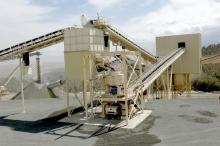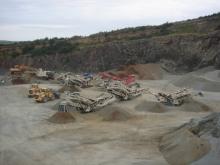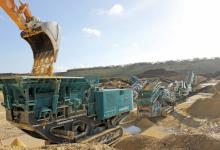
Crushing is a key process in the quarry operation but the choice of mobile or stationary units is no longer a straightforward one of tonnes per hour, Claire Symes reports.
In the early days of mobile crushing equipment the desired output was an easy deciding factor between whether a quarry needed the larger volumes offered by stationary equipment or the fast set-up of a mobile unit more. Today modern mobile equipment can match the capacity, quality and efficiency of many fixed plants, so the choice is no longer so simple and the ideal solution can even be a mix of the two.
The tracked new jaw plant was delivered to the Marche Les Dames quarry as a primary crusher to supply reduced material to the quarry's stationary secondary unit, which in combination crush 600,000tonnes of medium hard limestone each year. The 500tonne per hour mobile unit was supplied with a 160mm closed side setting and a three year service contract to provide Sagrex, new comers to the mobile market, with peace of mind.
"While we were not so familiar with mobile crushing, a three-year service contract was signed with Metso's distributor BIA," said Sagrex's manager responsible for investments, technical projects and energy Claude Schadeck.
"Now, we are very pleased. Thanks to the contract, the availability of Lokotrack has remained close to 100%." The Lokotrack at Sagrex's quarry feeds into an NP1520 and NP1315 impact crushers and material is screened by two Elivar 20 screens to provide end products of 0-4mm, 4-8mm, 8-14mm and 8-20mm.
But why make the switch from one approach to a mix of the two? According to Schadeck, the company had good experience of Metso's impact crushers and screens. "We wanted to standardize the supply of related equipment. Along with the expansion of our quarry operations, we extended our Metso fleet of machines," he said.
Metso Minerals business manager for in-pit crushing solutions Jorma Kempa added, "Using a full mobile primary crusher gives lots of options and keeping the secondary crusher as a stationary unit allows the plant to produce more fractions
"It is clear that when we first started to produced tracked equipment 20 years ago there was a trend for primary machines to be mobile and then the option for the secondary stage would depend more on the individual quarry.
"Today operations extend from fully mobile to completely stationary and every stage in between. There is no clear answer.
"Fully mobile is often the best solution for pilot plants and new developments, as well as smaller quarries in scarcely populated areas. Higher demand quarries nearer larger urban areas may need a fixed stationary plant for capacity but can be served by a mobile primary unit."
Mobile Options
Even when a quarry operator has selected to go for a mobile crushing solution, there are further decisions to be made - tracked or wheel mounted? In Western Europe there is a general preference for tracked equipment but in Eastern Europe, wheeled solutions are more common.
US-based
The Richmond, California-based company usually moved its crushing and screening equipment from its basalt quarry to its other quarries and recycling sites. Once sufficient stockpiles were built up in the quarry, the equipment would be moved but used to involve four or more men and 11 truckloads, including towing two crushers and a screen, and took 11 days.
Last year the quarry switched to a diesel-powered, track-mounted
"The old system was too complicated, cumbersome, and was costing us too much in lost production time, maintenance time and expense, and moving costs," said Dutra quarry manager Jon Guglielmini. "Sometimes we want to move the crushing and screening system from place to place within the quarry, to follow the face or put the equipment down in the pit. Moving the old wheeled system took two days. Moving the new tracked system takes two men about three hours."
The quarry now uses a Powerscreen 1180 Premiertrak jaw crusher, two 1300
New Entrants
The changing demand for mobile crushing equipment is underlined by the way major manufacturing companies have invested in order to have a stakehold in this business. In 2007,
At the time of the buyout, the company said that entering the growing mobile crushing and screening market will strengthen the group's position in the area of quarrying and recycling. Atlas Copco surface drilling equipment division president Andreas Malmberg added, "The acquisition strengthens Atlas Copco's position as market leader within surface rock excavation and handling, as well as within recycling and road construction.
"The product-line complements our current product-offering and makes us an even more complete partner. Our customers will benefit from having the same supplier for drill rigs, breakers, road construction equipment as well as mobile crushers and screeners."
The company is continuing to market Hartl Anlagenbau's product line under the Powercrusher name and the first machines rebranded as Atlas Copco were on display at the end of March at
But it is not just the global manufacturers that are pushing into the European mobile crushing market - competition from Turkey is also increasing.
Turkish crusher manufacturers have been building conventional jaw type units for many years, which have been used in the local market as well as being exported to North Africa and Asia for example.
However the country's major crusher manufacturers have more recently broadened their product ranges, offering a wider array of machines and featuring a higher degree of sophistication.
Burak Saral is machinery factory manager at Burçelik. He said that much of Burçelik's export production, around 90%, is for the North African and Asian markets although the firm has also supplied mobile crushers to Greece and impact crushers to France.
The current product line is broad and includes jaw, cone and impact crushers as well as VSIs, screening plants and dewatering systems. With Turkey's quarrying sector having focussed on using large stationary crushing plants, Burçelik has developed the capability to supply complete systems to customers that comprise primary, secondary, tertiary and screening equipment.
However, Burçelik has also widened its product line and is able to meet the tough European operating requirements for equipment, as well as supplying other manufacturers. Saral explained that the company also has a major subcontracting operation, making components for other manufacturers. He said, "We also have a foundry and we cast up to 40tonnes at a time. Every kind of industry needs large castings."
The firm has been building crushing and screening plants since the late 1980s and also sub-contracts crane components for
This has given the company particular experience of the tracked crusher sector and a comprehensive understanding of the design requirements for various international markets. Burçelik has developed its own design of machines to meet international needs and given the firm's strong sales into North Africa, the company could supply modern and high performance tracked crushers to the area should market demand prove sufficient.
To move or not?
"The overall trend is towards mobile equipment," said Kempa. "It is not a question of whether it is accepted anymore, it is now well proven and it is more about whether it is the right solution for the quarry in question.
"Where there is a real change underway is when it comes to energy costs. Customers are demanding more fuel efficient or electrically powered mobile machines. This is quite different from five years ago and the next big issue will be the new emissions legislation and the introduction of Stage IIIB powered machines." However no matter what suits the quarry best, there is still the issue of securing finances to invest in new technology. "The economic situation is improving though in most countries and we expect to see a slow increase in the level of investment," added Kempa.
"Funding is a key issue and it is always easier to finance a mobile plant than a stationary installation. The set-up time can also influence the investment towards mobile and in some countries it is much easier to gain consent for a mobile plant than a fixed one and this factor may well shape the market over the next few years."
Weather Worries
Once the decision has been made in terms of what equipment to invest in, focus naturally shifts to the maintenance of the crusher. Bonding specialist
"We may be getting over the worst of the winter weather but in many European countries we can probably expect periodic ambient temperatures of below 10oC for some time yet," said the company. "With this in mind it is important to give due consideration to the cure of the crusher backing material. Our new guide will help quarry operators get the best results." During the cold months there is little opportunity for either polyurethane or epoxy based systems to fully cure in the field. The result of incompletely cured crusher backing could range from premature backing failure to more serious damage to the crusher itself.
According to Korroflex, to a full cure with a standard epoxy system it is normally recommended to maintain the system above 10oC and, if possible, nearer to 20oC for as long as possible. With surface and ambient temperatures below 10oC typical epoxy and polyurethane systems will not be able to achieve a full cure at all and even at 10oC a full cure is severely retarded and would take several days. "The best way to reduce curing rates is to warm up either the product or the tool, but deciding by how much and for how long is not easy to calculate," said the company. "This is because there are a number of important dynamics linking tool temperature, product temperature and maximum casting thickness, all of which must be considered.
"Getting this wrong can result in some major issues. For example, heating the crusher backing excessively prior to mixing, will result in a dramatic reduction in pot life and could lead to excess exotherm and subsequent shrinkage. Overheating the tool prior to pouring could have similar effects. "Our new guide provides a detailed application temperature correlation table to help improve crusher maintenance."









